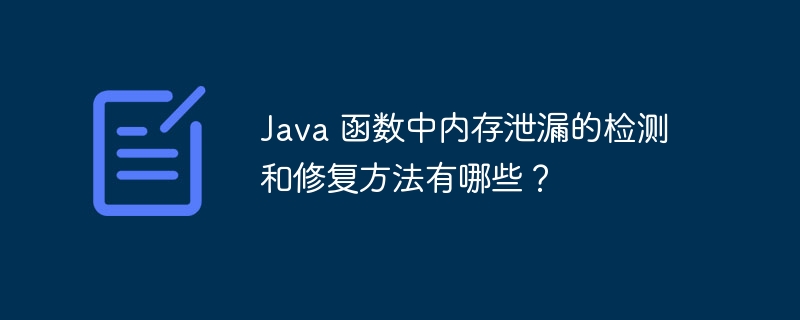Home >Java >javaTutorial >What are the ways to detect and fix memory leaks in Java functions?
What are the ways to detect and fix memory leaks in Java functions?
- WBOYWBOYWBOYWBOYWBOYWBOYWBOYWBOYWBOYWBOYWBOYWBOYWBOriginal
- 2024-04-30 16:21:021135browse
Methods to detect memory leaks: 1. Use memory analysis tools; 2. Add log statements to track memory; 3. Regular code reviews. Steps to fix memory leaks: 1. Use weak references or PhantomReference; 2. Use static variables with caution; 3. Disable unnecessary listeners. Practical case: A large list was created in the LeakyClass class, but the strong reference was not released. After the fix, the cleanup() method was called to destroy the strong references and free the memory.

Exploring the detection and repair of memory leaks in Java functions
Introduction
A memory leak refers to a situation where memory is allocated in a program but is no longer used, resulting in the inability to free the memory. This can cause severe performance issues or even crash the application. Memory leaks are particularly common for Java functions because they use automatic garbage collection, and the garbage collector is not always efficient enough.
Detecting memory leaks
There are several ways to detect memory leaks:
- Memory analysis tools:For example VisualVM and JProfiler, these tools can analyze heap memory usage and help identify potential memory leaks.
- Logging: Add log statements in the function to track memory allocation and release. This helps identify leaks manually.
- Code review: Regularly check the code to see if any object references have not been released.
Fix memory leaks
Once a memory leak is detected, you can take the following steps to fix it:
- Use weak references: For objects that are no longer used, use weak references instead of strong references. Weak references do not prevent the garbage collector from releasing the object.
- Use PhantomReference: This is a weak reference that will be notified when the object is garbage collected. This helps with cleanup operations.
- Use static variables with care: The life cycle of static variables is the same as the life cycle of the application, and they can cause memory leaks.
- Disable unnecessary listeners: Listeners should be disabled or removed when no longer in use to free up resources.
Practical case
The following is a sample code for a memory leak:
class LeakyClass {
private List<Object> leakedList;
public LeakyClass() {
leakedList = new ArrayList<>();
for (int i = 0; i < 1000000; i++) {
leakedList.add(new Object());
}
}
}
public class MemoryLeakExample {
public static void main(String[] args) throws Exception {
new LeakyClass();
Thread.sleep(1000); // 给垃圾回收器时间运行
// 检查是否有泄漏
VisualVM visualVM = VisualVM.attach();
HeapDump heapDump = visualVM.dumpHeap();
Instance[] leakedObjects = heapDump.findInstances(LeakyClass.class);
if (leakedObjects.length > 0) {
// 内存泄漏已检测到
System.out.println("内存泄漏已检测到!");
}
}
}The code to fix this memory leak is as follows:
class LeakyClass {
private List<Object> leakedList;
public LeakyClass() {
leakedList = new ArrayList<>();
for (int i = 0; i < 1000000; i++) {
leakedList.add(new Object());
}
}
public void cleanup() {
leakedList = null; // 销毁对列表的强引用
}
}
public class MemoryLeakExample {
public static void main(String[] args) throws Exception {
LeakyClass leakyClass = new LeakyClass();
Thread.sleep(1000); // 给垃圾回收器时间运行
leakyClass.cleanup(); // 手动调用清理方法
// 检查是否有泄漏
VisualVM visualVM = VisualVM.attach();
HeapDump heapDump = visualVM.dumpHeap();
Instance[] leakedObjects = heapDump.findInstances(LeakyClass.class);
if (leakedObjects.length == 0) {
// 内存泄漏已修复
System.out.println("内存泄漏已修复!");
}
}
}The above is the detailed content of What are the ways to detect and fix memory leaks in Java functions?. For more information, please follow other related articles on the PHP Chinese website!
Related articles
See more- Summary of methods and principles of Java garbage collector
- Testing the impact of garbage collector GC on throughput in Java
- PHP kernel - graphic introduction to memory leaks and new garbage collection mechanism
- What are memory leaks and memory overflows in java
- Optimizing JVM memory parameters: Optimizing the garbage collector to improve application performance

